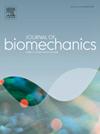Linear and angular impulse generated by high school pitchers during fastballs and changeups
IF 2.4
3区 医学
Q3 BIOPHYSICS
引用次数: 0
Abstract
This study revealed how high school pitchers generated momenta during fastballs and changeups at a whole-body level. Baseball pitchers control ground reaction forces to generate whole-body momentum. Pitchers attempt to throw as fast and accurately as possible during fastballs but also need to throw off-speed pitches like changeups to deceive batters. To understand whole-body momenta generation in fastballs and changeups, this study aimed to determine (a) the roles of each leg in impulse generation in high school pitchers, (b) if these impulses differed between fastballs and changeups, and (c) if net impulses related to ball speed. Linear mixed models revealed that the back leg generated significantly more forward linear impulse (p < 0.0001) and more angular impulse about the leftward (p < 0.0001) and upward axes (p < 0.0001) than the lead leg in fastballs and changeups as a group and within each pitcher. However, when comparing fastballs and changeups, there were no significant differences in net forward linear impulse (p = 0.71) or net angular impulse about the leftward axis (p = 0.42) or about the upward axis (p = 0.72) at the group-level, despite significantly greater ball speeds during fastballs (p < 0.0001). This study did not detect any significant group-level associations between ball speed and net forward linear impulse (p = 0.6 for fastballs, p = 0.81 for changeups) or net angular impulse about leftward axis (p = 0.52 for fastballs, p = 0.35 for changeups) or about the upward axis (p = 0.76 for fastballs and changeups) during fastballs or changeups, though some participants exhibited trends between impulses and ball speed individually.
求助全文
约1分钟内获得全文
求助全文
来源期刊

Journal of biomechanics
生物-工程:生物医学
CiteScore
5.10
自引率
4.20%
发文量
345
审稿时长
1 months
期刊介绍:
The Journal of Biomechanics publishes reports of original and substantial findings using the principles of mechanics to explore biological problems. Analytical, as well as experimental papers may be submitted, and the journal accepts original articles, surveys and perspective articles (usually by Editorial invitation only), book reviews and letters to the Editor. The criteria for acceptance of manuscripts include excellence, novelty, significance, clarity, conciseness and interest to the readership.
Papers published in the journal may cover a wide range of topics in biomechanics, including, but not limited to:
-Fundamental Topics - Biomechanics of the musculoskeletal, cardiovascular, and respiratory systems, mechanics of hard and soft tissues, biofluid mechanics, mechanics of prostheses and implant-tissue interfaces, mechanics of cells.
-Cardiovascular and Respiratory Biomechanics - Mechanics of blood-flow, air-flow, mechanics of the soft tissues, flow-tissue or flow-prosthesis interactions.
-Cell Biomechanics - Biomechanic analyses of cells, membranes and sub-cellular structures; the relationship of the mechanical environment to cell and tissue response.
-Dental Biomechanics - Design and analysis of dental tissues and prostheses, mechanics of chewing.
-Functional Tissue Engineering - The role of biomechanical factors in engineered tissue replacements and regenerative medicine.
-Injury Biomechanics - Mechanics of impact and trauma, dynamics of man-machine interaction.
-Molecular Biomechanics - Mechanical analyses of biomolecules.
-Orthopedic Biomechanics - Mechanics of fracture and fracture fixation, mechanics of implants and implant fixation, mechanics of bones and joints, wear of natural and artificial joints.
-Rehabilitation Biomechanics - Analyses of gait, mechanics of prosthetics and orthotics.
-Sports Biomechanics - Mechanical analyses of sports performance.
 求助内容:
求助内容: 应助结果提醒方式:
应助结果提醒方式:


